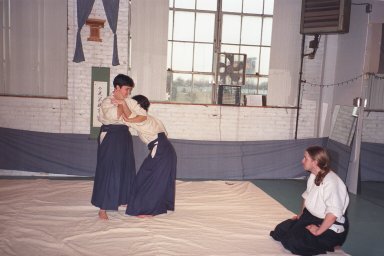What
is Aiki?
Is
what you do aikijujutsu or aikido?
Do you teach
self-defense?
Isn't
jujutsu groundfighting?
The old
website mentioned 'aikibudo'... why has that changed?
Why haven't I heard of
Shintai before?
What
is Shintai like?
Do
you teach kata?
Do you do tournaments or competitions?
Can Shintai be used in competition?
Do
you spar?
Can I just learn one section of the art and
nothing else?
What
does it mean that Aoi Koyamakan is a private school?
Why
do you do interviews?
Can
I watch a class?
Do
you have a children's program?
I've
never studied a martial art before, what should I expect?
Rolling and falling- does that
hurt?
What
do I need to start training?
How
long does it take to make black
belt?
If you don't use belts what
is the ranking structure like?
What
is Aiki?
Aiki
(eye-khi; emphasis on the fist syllable) comprises two kanji
(Sino-Japanese ideograms)- 'ai' harmony and 'ki' (intrinsic or
esoteric) energy.
Is
what you do aikijujutsu or aikido?
Neither.
Aikijujutsu is a term properly used only for schools tied to or
descended from the Daito Ryu (of the Kii Takeda and transmitted
through Takeda Sokaku); aikido was created in the 1930's by Ueshiba
Morhei, based on Daito Ryu.
The chief art that we practice, Tenshin Shintai Ryu (Shintai, for short) is a jujutsu system; while the term 'aiki' is used, in Shintai it describes high-level hyoshi (timing), mostly, relating to sword- it is not aikijujutsu.
Do you teach
self-defense?
No, at least not in the way that that term is commonly used.
Training
in Shintai will improve striking, comfort
grappling and provide the
experience of having someone 'enter your space' aggressively; with that
said, the two central skills in avoiding/surviving conflict
are comportment and situational awareness- both of which can
be
trained outside of a 'martial' art.
If the goal is to learn to fight quickly,
there are other, (much) more efficient ways (E.G. western boxing,
catch/folk wrestling, Indonesian Kuntao, etc.) that can be taught
without cultural/contextual trappings.
Isn't jujutsu
groundfighting?
Jujutsu
(flexible, supple or pliant tactics) is a broad category of Japanese
arts that covers a range of combative situations, both unarmed
and with tools. Most jujutsu in America derives from Judo, whether in
'Brazilian' Jiu-jitsu (which features a very sophisticated
ground-grappling component) or modern 'eclectic' jujutsu schools.
Older-style jujutsu system like Shintai make use of sutemi waza (sacrifice techniques, ones in which tori [the' taker' or 'winner' of the technique] gives-up a standing position), but there is almost no unarmed ground-based grappling in the curriculum.
The old website said that you teach 'aikibudo'... why has that changed?
That 'Aikibudo' curriculum was a composite system designed to provide a basis in traditional arts in preparation for training Shintai, however since receiving Menjo (teaching license) from Mr. Tasker, we have opted to drop the 'filter' to concentrate on the main art.
Why
haven't I heard of Shintai before?
Despite developing a reputation for excellence locally both at home
and while here in America, Mr.
Nakayama always declined offers to join 'martial' arts
umbrella organizations or to have Shintai featured in
publications. By the time his dojo (正視古館
柔術 道場)
closed
to the public, Mr. Nakayama only had two active students.
With none of the standard means of increasing public
awareness
(e.g. famous teachers or members, a large student
body, advertising, publishing, major
affiliations, etc.) of what had been a family art, Shintai has remained
small.
What
is Shintai like?
Shintai
combines pragmatic physical
(combative and healing) skills as well as a means of preserving
older, more esoteric elements such as Yoroi
Kumiuchi
(armored grappling), and use of weapons, such as swords, spears and
chain-weapons. A
core set of kihon
(lit. tree roots or basic skills) inform the taijutsu
(body tactics- striking, throwing and grappling), use of
weapons and
healing.
For more on the tokushitsu
(characteristics) of Shintai, please
see this page
Do
you teach kata?
Yes, kata (forms) are the main method of
transmission in Shintai.
Despite the reputation for kata-based training as just 'going through the motions' or 'repeating dead patterns,' for us, most kata are highly interactive two-person sets. Once you learn the gross format, the forms 'evolve' to include greater resistance (working up to deliberate countering) from uke (the receiver or 'loser' of the exchange), usually, a senior. Training in this way discourages complacency or 'blank-stare training' as it has been called.
Are
there tournaments or competitions in this art?
No.
Can Shintai be used in competition?
The
skills needed for MMA-style engagements are specialized and require
immense dedication.
While it might be possible to adapt Shintai to function in a
ring/octagon, there are already expert trainers out there with
experience cultivating peak performance from combat athletes.
On the other end of the spectrum, it might be possible to
enter
kata competition using Shintai weapons forms but realistically due to a
lack of flashy techniques, it is
an unlikely fit there either.
Do
you spar?
The training method for arts of this type involves working against
progressive resistance (and eventually, active countering) by
partners (usually seniors or instructors) in taijutsu and with weapons.
In addition, we practice drills that reinforce skills under
less
structured (somewhat chaotic)
circumstances with the aim of functionalizing and pressure-testing
while avoiding some of the pitfalls and dangerous habits that 'sparring' can introduce.
Can
I just learn one area of the art (sword, spear, taijutsu, etc.) and
nothing else?
No. Arts of this type are more than a collection of
techniques
(or even their underlying strategies)- each area enriches and
reinforces other, sometimes seemingly unrelated, skills.
One way to think of a Ryu (flow- art or 'style') is like a computer. The body skills are the hardware, the principles, the Operating Sytem (OS); individual skill-sets as programs or applications. The hardware allows the OS to function and it is on that framework that programs run. To somewhat strain this analogy, Shintai techniques will run on different hardware and 'OS', but without the the body skills (power generation, sensitivity, awareness of posture, weight transitions, breathing, etc.) and the underlying theory, you won't get 100%.
Similarly, the maai (distancing)/hyoshi (timing) innate to interacting with weapons and the knowledge of physiology derived from manual therapy vastly alters one's relationship to training and understanding of the process. In short, doing only a portion of the art would be like removing legs from a stool... it may look cool, just don't expect it to withstand any weight or pressure.
Is this school Aiki Budokai or Aoi Koyamakan?
Both. The 'kai' in Aiki Budokai (ay-khee boo-doughkhai) means 'association;' the 'kan' in Aoi Koyamakan (ah-oy koh-yama-khan) is 'hall.' Without a dedicated space in which to train, the designation 'Aiki Budokai' was the constant from one site to another. Since building the Aoi Koyamakan as our home, that name is more apt and moving forward, the way in which we will refer to the dojo.
What
does it mean that Aoi
Koyamakan
is a private school?
Unlike a gyms, health clubs and many commercial schools, we have found
it
counterproductive to be populated by students who do
not
attend classes regularly (continuing membership through
contracts.) Similarly, there
are expectations for all members of the dojo
(including keeping notes and regular personal
training outside of classes.)
Rank promotions are free (if
infrequent), and there no association dues, yearly membership or
other 'special' fees. To ensure that everyone receives
adequate
space and individual instructional attention, total enrollment
is limited to six active students (once reached,
prospective students may, if they wish to, join a waiting list.)
It is also important to note that our dojo is part of a home in a
residential area; because of this, we cannot accommodate anyone
without an appointment. To schedule a visit, please E-mail or call to
arrange an interview.
Why
do you do interviews?
The
brief (+/- 15 minutes) telephone interview (or in-person meeting)
with the instructor is to learn a bit about you, your background,
interests, goals for training, and to answer questions that you may
have. If, based on that, it seems appropriate,
we will schedule a couple of classes for you to participate in; if not,
we can recommend other schools in
the area that may be more in line with what you are looking for.
Can
I watch a class?
Because
the body mechanics of jujutsu can be deceptive, we strongly encourage
that you plan to participate in, rather than watch, two to three
training sessions (there is no fee for this.)
Do
you have a children's program?
We
do not currently offer classes for anyone under the age of 17.
I've
never studied a martial art before, what should I expect?
A
regular class consists of some minor warm-ups, stretching, ukemi
(receiving body, rolling and falling safely), partner work and
weapons or healing. Over the two months of the Introductory
Course,
you will be exposed to all of the basic skills (things like falling,
striking, footwork, body
conditioning, power generation
and spatial awareness exercises) that will act as the building blocks
for more advanced skills.
Rolling and falling-
does that hurt?
Ukemi (receiving body) is one of the most fundamental and practical
skills in jujutsu; in daily life, falls can be a very harmful- knowing
how to stay calm and avoid unwanted tension in the body can make all
the difference. Through progressive stages of practicing
ukemi,
the body becomes accustomed to responding appropriately to falls on a
variety of surfaces without pain.
Although initially simply rolling, falling and landing safely, ukemi practice deepens to provide a basis for the timing, sensitivity and alignments for countering techniques.
What
do I need to start training?
For
the Introductory Course, loose comfortable clothing like sweat pants
(or any that cover the knees and do not inhibit movement) and
T-shirts (without logos) are fine. Following the two-month
Introductory Course, some students will be asked to join as members.
If you agree to join the dojo, you will need to acquire a
keikogi and weapons of your own (we don't sell equipment but can
recommend retailers for clothes and tools.)
I'm
from another school or from out of town, can I train with you?
Yes, we are happy to host and greatly
enjoy interacting
with practitioners of other arts. It is
simplest to E-mail ahead to schedule a call or meeting outside
of class.
Keikogi for the dojo is either an unadorned (any color, as long as it's white) judogi/canvas karategi or, a white uwagi, black or blue hakama and kaku obi of any color/pattern.
How long does it
take to make black
belt?
The
use of belts to denote rank is a relatively new practice, one
never adopted in Shintai; instead one is conferred with densho
(scrolls)
or Mokuroku
(catalogue of techniques), the first of which is Shoden Mokuroku.
While every art is different (and it can be difficult to draw direct parallels) Shoden Mokuroku is roughly equivalent to a low (1 - 2) dan (black-belt rank) in roughly similar systems, and can take anywhere from 3 to 9 years of consistent training to complete.
If you don't use belts what
is the ranking structure like?
There are three densho,
Shoden
(new or first-level scroll), Chuden
(mid-level scroll) and Okuden
(esoteric or inner scroll) Mokuroku,
each with body, weapons skills, and
strategies (though all built on kihon.)
After completion of Okuden Mokuroku there is a fourth level,
Menkyo Kaiden (complete transmission), that
includes learning the limited selections of preserved kata from the four main influencing
arts.
The only outward sign of 'rank' is uwagi (jacket) color, that is, after completing Shoden Mokuroku one may wear blue, or, on (rare) formal occasions, instead of grey kimono, one may wear black.
As a final note, Menjo (teaching licenses) are specific, separate from the densho and can only be awarded by those holding Menkyo Kaiden.

Copyright © Aiki Budokai/Aoi Koyamakan


